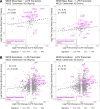This is a preprint.
Cross-platform proteomics signatures of extreme old age
- PMID: 38645061
- PMCID: PMC11030369
- DOI: 10.1101/2024.04.10.588876
Cross-platform proteomics signatures of extreme old age
Update in
-
Cross-platform proteomics signatures of extreme old age.Geroscience. 2025 Feb;47(1):1199-1220. doi: 10.1007/s11357-024-01286-x. Epub 2024 Jul 25. Geroscience. 2025. PMID: 39048883 Free PMC article.
Abstract
In previous work we used a Somalogic platform targeting approximately 5000 proteins to generate a serum protein signature of centenarians that we validated in independent studies that used the same technology. We set here to validate and possibly expand the results by profiling the serum proteome of a subset of individuals included in the original study using liquid chromatography tandem mass spectrometry (LC-MS/MS). Following pre-processing, the LC-MS/MS data provided quantification of 398 proteins, with only 266 proteins shared by both platforms. At 1% FDR statistical significance threshold, the analysis of LC-MS/MS data detected 44 proteins associated with extreme old age, including 23 of the original analysis. To identify proteins for which associations between expression and extreme-old age were conserved across platforms, we performed inter-study conservation testing of the 266 proteins quantified by both platforms using a method that accounts for the correlation between the results. From these tests, a total of 80 proteins reached 5% FDR statistical significance, and 26 of these proteins had concordant pattern of gene expression in whole blood. This signature of 80 proteins points to blood coagulation, IGF signaling, extracellular matrix (ECM) organization, and complement cascade as important pathways whose protein level changes provide evidence for age-related adjustments that distinguish centenarians from younger individuals.
Keywords: Serum proteomics; extreme longevity; mass spectrometry; somalogic.
Conflict of interest statement
Statements and Declarations: Competing interests. The authors declare no competing interests.
Figures




Similar articles
-
Cross-platform proteomics signatures of extreme old age.Geroscience. 2025 Feb;47(1):1199-1220. doi: 10.1007/s11357-024-01286-x. Epub 2024 Jul 25. Geroscience. 2025. PMID: 39048883 Free PMC article.
-
Protein signatures of centenarians and their offspring suggest centenarians age slower than other humans.Aging Cell. 2021 Feb;20(2):e13290. doi: 10.1111/acel.13290. Epub 2021 Jan 29. Aging Cell. 2021. PMID: 33512769 Free PMC article.
-
Longitudinal analysis of host protein serum signatures of treatment and recovery in pulmonary tuberculosis.PLoS One. 2024 Feb 29;19(2):e0294603. doi: 10.1371/journal.pone.0294603. eCollection 2024. PLoS One. 2024. PMID: 38421964 Free PMC article.
-
Proteome research based on modern liquid chromatography--tandem mass spectrometry: separation, identification and quantification.J Neural Transm (Vienna). 2006 Aug;113(8):973-94. doi: 10.1007/s00702-006-0509-3. Epub 2006 Jul 13. J Neural Transm (Vienna). 2006. PMID: 16835695 Review.
-
[Advances in high-throughput proteomic analysis].Se Pu. 2021 Feb;39(2):112-117. doi: 10.3724/SP.J.1123.2020.08023. Se Pu. 2021. PMID: 34227342 Free PMC article. Review. Chinese.
References
-
- Sinha A, Mann M (2020) A beginner’s guide to mass spectrometry–based proteomics. The Biochemist 42:64–69. 10.1042/BIO20200057 - DOI
Publication types
Grants and funding
LinkOut - more resources
Full Text Sources
